< home < content cubic organisms >
RIMMA GERLOVINA
THE CUBES
© 2010, Rimma Gerlovina and Valeriy Gerlovin
PART 5
In 1975, the small boxes grew into the Cubes-Environments, the series of the projects, in which the spectator is turned into a performer. Upon entering each of these objects with different settings, one unintentionally follows its scenario. These works syncretize elements of diverse genres, entwining environmental art with conceptualism, dramaturgy and polyphonic poetry. The Cubes-Environments are issued in the series of thirty-three booklets, each for a single project.
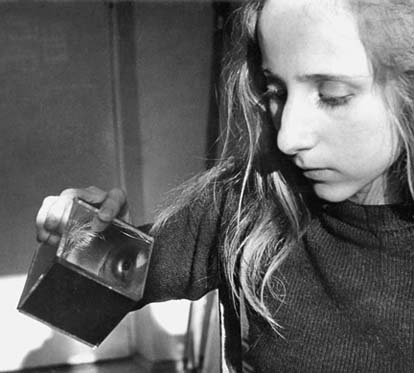
Rimma
Gerlovina, Mirror cube, 1975, Visual prove that one is always on that side
of the cube, which one is facing. |
The series opens with the two-meter side Mirror Cube, 1975, all interior sides of which are made of mirrors. Upon entering that cube, the spectator finds himself in the focus of all its six mirrors, astonished by enormous multiplication of his own reflection. The immersion into the environment with reverberating self-image is accompanied with the repercussive quadraphonic sound. The polyphonic poem is recited slowly, similarly to echo by an announcer whose voice preferably would have hypnotic qualities. The text is recorded by means of superimposition, producing a multi-voiced resounding. Here, one experiences the effect of audible and visual synchronization of the echo and the infinite corridor of reflections of the listener. One intermediate strophe from that sound poem might give a sense of its dominant rhythm, the unison of "I am" and dispersion of all other meanings. (Link to the original text)
1st voice: ............................................................................................................................................
2nd voice: ...........................................................................................................................................
3rd voice: I am continuation of life I am continuation of life I am continuation of life I am continuation of life
4th voice: I am pores I am ready I am here I am seeing I am hearing I am people I am sample I am number
5th voice: I am photo I am volt I am veto I am hundred I am spectrum I am litre I am meter I am point
The life of an artist usually has many twists and turns; in a way, it is a happening in itself. From the point of view of an ordinary person, it looks rather like a "mishappening," just as it does in the series of Cube-Environments. In some sense, psychoanalytic projects contain elements of visual poetry and more importantly, they are written with a sense of irony. They translate certain grotesque situations into visual dramatizations, and they are not only idiosyncratic for people who have a creative vision, but also for those who "suffer" from extra keen observation and sensitivity. Among them, The Displacer (1975) is particularly significant. It demonstrates the paradigm of an objective process, a kind of deliverance from nature's constraints. It is conceived and played out by nature itself, wherein the personal ego is slowly processed by the power of the impersonal, similarly to a rough diamond getting a brilliant cut. In strictly conceptual form, it shows both the process and the outcome.

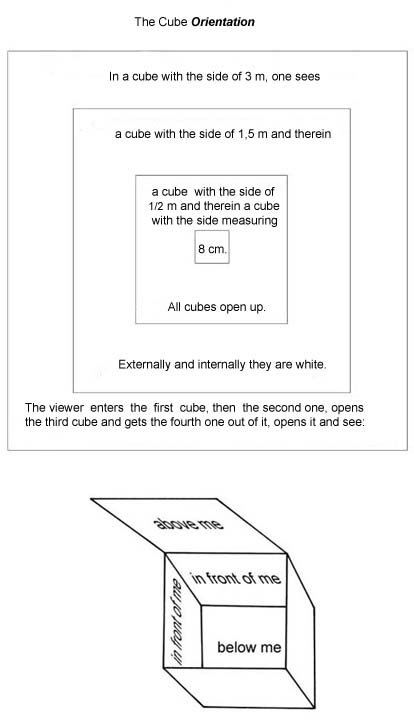


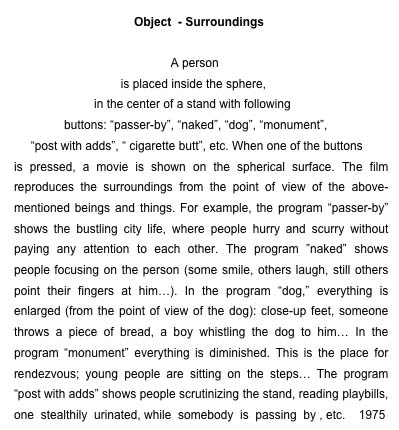
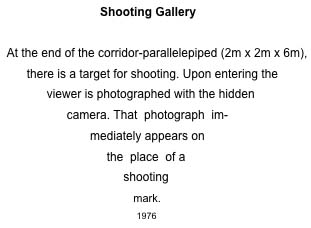
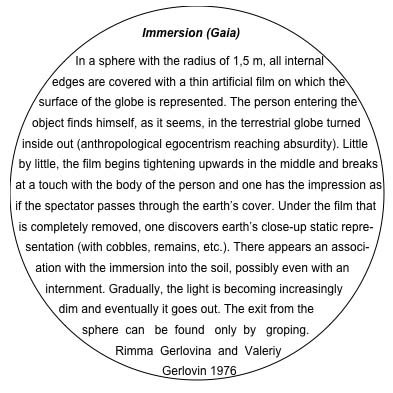

Companion
The spherical room with a 2-meter (around 2 yards) radius circumferential base is intended for individual use. The system is put into operation by opening the entrance door. In the middle of the room there is a swivel chair. The inner surface of the object excluding the base, is a screen. The movie is as follows: A room with restraint but exquisite furniture, reminding of a study. A middle-aged man of intellectual appearance is standing by the window with his back to the person entering the object. The man turns and greets the person: - Please, come in...Sit down... (The man scrutinizes the newcomer, though unobtrusively.) - Sit in the sofa...very comfortable there. (points with his eyes to the soft leather sofa) - Sorry, I forgot it's not easy for you... (He smiles and slowly approaches an armchair. Near it there is a journal table with a few books, an ashtray and a cigarette case. The man makes himself comfortable in the armchair. A brief pause.) - You know this kind of weather is not good for me... (He looks towards the window, playing his fingers on the cigarette case, and looking now and then at the visitor.) - I see it doesn't affect you... - I beg your pardon, but I know neither your name nor your occupation... (a brief pause) - Though this doesn't matter... I talk to all in one manner... (He looks around the room as if thinking over his next words, and then addresses the visitor:) - I believe we see each other for the first time... - I feel we've met somewhere before... (He again assumes the initial pose, tapping on the cigarette case. He doesn't look at the visitor.) - All faces have elements of this of that human type... (He stands up and approaches the table.) - Sorry, I can't offer you a cup of coffee... (He taps on the table and sings a tune.) - Do you like the painting? (He nods to the landscape painting by an unknown artist of 19th century.) - I think it's great... (a pause) - You expect me to say anything else? (a pause) - I don't expect anything of you. (It rains outdoor.) - It seems to be raining... (The man comes up to the window and opens it. It rains heavily. Looking at the visitor, he says:) - You don't have an umbrella... Let's hope it will soon stop. (again smiles) - I think I shouldn't worry too much... (a two min. pause. The man paces up and down the room, thoughtfully replacing various articles and glancing at the visitor. The telephone rings.) - I beg your pardon, I must leave you. I'll be back soon. In case you are in a hurry, you are free to leave. (He says good-bye and leaves. Never comes back. The picture on the screen does not change: it rains heavily.) The visitor can stay and wait for the companion for as long as he or she likes. The experiment is over. The image disappears only when the spectator leaves the room. January 1, 1976 (Translated by Keith Hammond) |
Demonstration Cube
The 2.5-meter cube (around 2.5 yards) side cube has in-built equipment. The system is intended for individual use. Entrance is through one of the side faces of the cube, which is white inside; the lighting is bright (fluorescent.) A person inside should not know about the principle of its demonstration. The system is put into operation by pressing a buttons "M" for men and "W" for women. One minute after a person enters the cube a recording is put on: the approaching steps and indistinct conversation, producing an illusion that four persons are approaching the cube (one woman and three men.) Their conversation is becoming clear:
- Here's the cube - Yes, I see - ... - ... - Let's have a closer look... (Steps are approaching; voices are getting louder.) - ...Nothing interesting - ... - Well, as always... - Shall we...? - ... - Let's - Yes, let's see what's inside... - ... - Who's there... Who's there... (singing) - ... - Well, press it! - ... - Quicker! Quicker! (At this point glassed peepholes appear in the middle of each side. In three of them life-size eyes appear.) - ... - ... - Let me see! - Go over to the other side! - ... - ...There's enough room for all, come here... (Again steps are heard.) - ... - ... (All look in silence.) - ... - ... - Well?... - ... - Sorry? - ... - It's nothing. - ... - Like it? - ... - Yeah... - ... - What's he doing here?... - ... - As usual... - ... - Also watching... - ... - Yes, watching... (The voices agree.) - ... - Well? (waiting) - ... - This is all right... - Yeah, it might be worse... - ... - He looks arrogant... - ... - ...So?... (waiting) - Wait, let's see what he does... - ... - Hardly anything... He looks like... - Yes? - ... - You see yourself... - ... - Oh, I see... - ... - He is blinking his eyes - ... - I can't see from my place... - Well, come here... - It's all right... - ... - So puffy... (all laugh) - ... (knocking with nail on the side of the cube) - Are you knocking? - ... - Yes... - ... - He looks embarrassed now... - Not very interesting... - ... - No... - Why are you silent?... - ... - Watching... - ... - Again blinking... - ... - Hands are red... (all giggling) - ... - Enough, let's go... - ... - Yeah, let's go... - ... - Wait... - To hell with him... (One eye disappears.) - ... - If only we could throw something there... - ... - Enough for me... - I am bored too, lets go... (Eyes disappear from other two holes. One eye remains.) - Well, shall we go? - ... - All waiting for you... - Let's go... - ... - Just a minute, he is looking in my direction... - ... - Let's go... - All right... (The last eye disappears. Steps retire; the conversation is indistinct and gradually dies down. One minute later the cube opens. The experiment is over.) 1975 (Translated by Keith Hammond) |
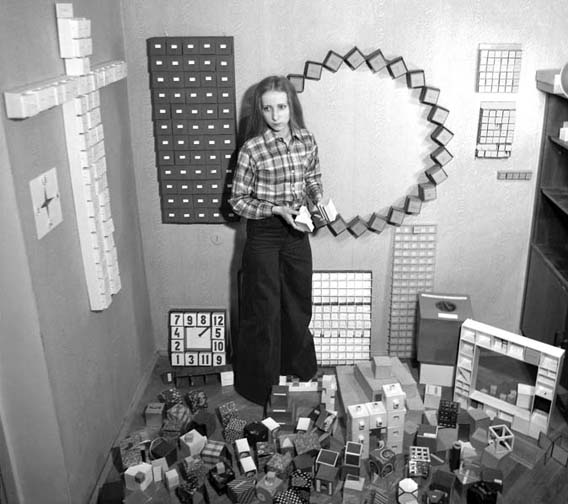
Rimma Gerlovina with the cubes, 1976, Moscow.
Parallel to the Cube-Environments, different multi-cell objects were made at that time, such as, The Pyramid (1975), The Clock (1975), Rabinovich (1975), An Ideal Man (1976), Paradise-Purgatory-Hell (1976; Fig.), The Circle (1976), and The Apartment House (1976: Fig.).
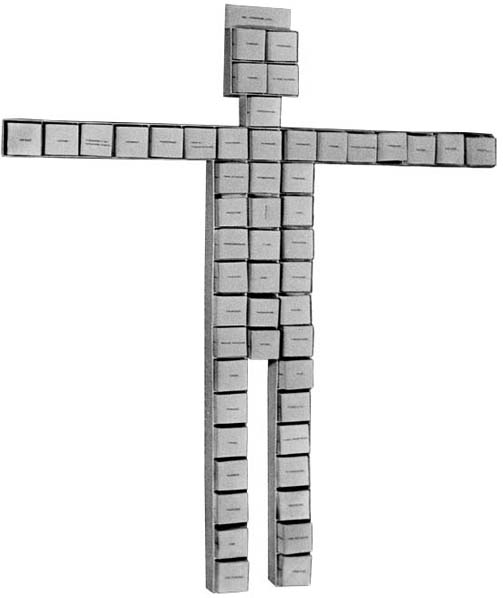
Rimma
Gerlovina, An Ideal Man: Each cube has text in Russian on every side, ranging the
concepts from positive to negative meaning, such as: "rational –
realistic - normal – queer – abnormal – crazy." Turning over
the cubes, it is possible to trace the line from genius to stupid, from saint
to devil, etc. The spectator can arrange the cubes, creating a character. 1976, cardboard, paper, mazonite, 42 x 36 x 2½". |
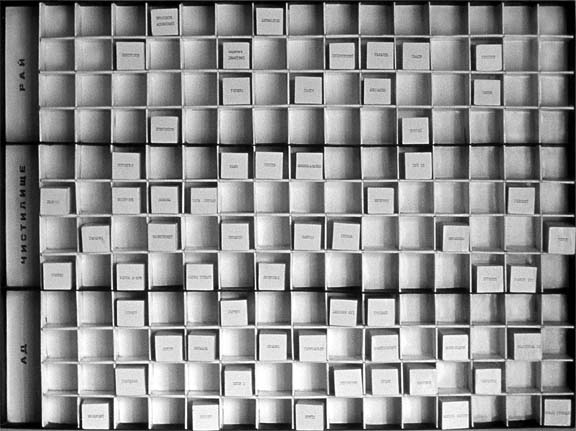
Rimma Gerlovina, Paradise
– Purgatory – Hell: The spectator can group 60 cubes
with names of famous people into three categories, passing the judgments on the
condition that only names are mortal. The set of the celebrities includes:
Socrates, Nefertiti, Galileo, Joan of Arc, Nietzsche, Napoleon, Raphael, Nobel,
Confucius, Lincoln, Freud, Stalin, Picasso, Bakunin, Ramses XVI, Gagarin, the
Beatles, Dante, the expert in afterlife judgment, and others. 1976, wood,
cardboard, paper, 22 x 16½ x 1¼". Collection of The State
Tretyakov Gallery. (link) |
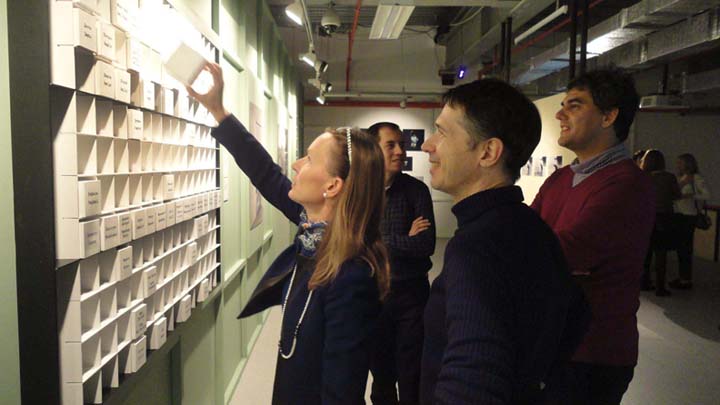
Rimma Gerlovina, Paradise – Purgatory – Hell, recreated in a large size at the exhibition "Performance in Russia: a Cartography of its History", Garage Museum, Moscow, 2014. On TV http://tvkultura.ru/article/show/article_id/120862 |
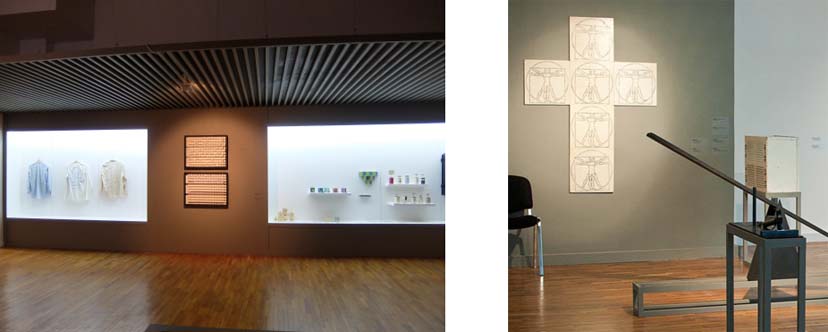
The New exposition at the State Tretyakov Gallery, 2016-17. On the left photograph, works by Rimma Gerlovina: Paradise-Purgatory-Hell is in the middle, the original work and its copy below, in which the spectators can move the cubes. On the right, under the glass, there are small cubes. Valeriy Gerlovin's works are on the right photograph: The Leonardo Cube in the unfolded position and the white Age Apparat. |
Each numbered cubic cell in The Apartment House represents, as one can expect, an apartment, occupied by small cubes. Its doors can be opened, exposing the interior and the tenants, who tell us about their personal problems, each having his or her distinct voice.

Rimma Gerlovina, The
House, a full view and the fragment, plywood, wood, cardboard, fabric,
text, 1976, 37¾ x 15¾ x 3¼". Collection of Renate and
Reinhold Bertlmann, Vienna, Austria |
In the middle of the confused daily round of that house, there is apartment #55, the dweller of which removes his projection from the crumbling world riddled with imperfection of every kind. We learn about him from his neighbors. For example, some of them call him a "yogi," while others simply call him a "creasy."

The diagram of the content of several apartments can give a preliminary picture of that establishment.
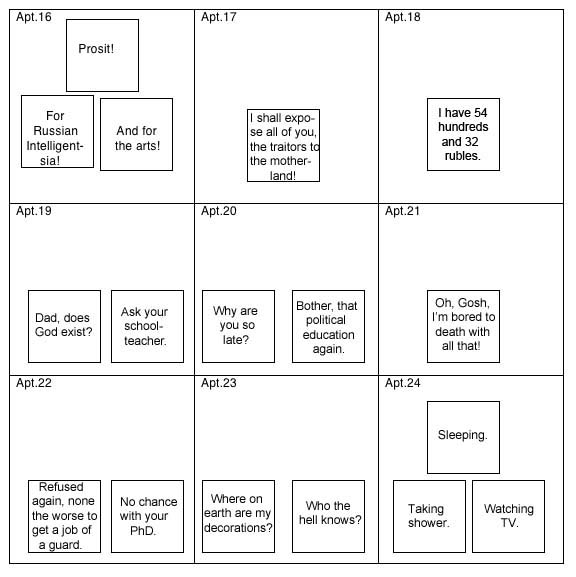
In New York during the 1980s, the molecular structure of the cubes was transformed into the human-size figures that formed the new series of English speaking Cubic Organisms. Similarly to a biological process, the small cubic cells grew into big cubic organisms. In general, our works obtained another face but retained the same message, albeit modified under the new conditioning. It seemed that we moved from the early "Greek" sensibility, strictly conceptual, characteristic to our Moscow period to the "Roman" monumentality of forms typical of our time in New York.

Rimma Gerlovina, Cubic Organisms, installation view of the joint retrospective exhibition An Organic Union at Fine
Arts Museum of Long Island, Hempstead, NY, 1991. |
The cubes can be found in the following public collections (links below):
Jean Brown Collection, The Getty Research Institute, Los Angeles, CA
The State Tretyakov Gallery, Moscow, Russia
Centre Pompidou Collection: (Cubes) (Mirror Game) (2x2=4) (Ursa Major)
Museum Moderner Kunst Stiftung Ludwig, Vienna, Austria
Zimmerli Art Museum, Rutgers University, NJ
The Concepts, book,1012 (info) (link to the pdf)
Thought of Thoughts, series of books; about the Cubes and Cubic Organisms in book 2 Trespassing
< home < content cubic organisms >